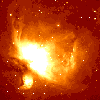The Orion Nebula

This page captured from the site at:
http://www.astro.lsa.umich.edu/users/iotm/oct95/orion.html
Nearest, brightest and most spectacular of the gaseous nebulae, the Orion Nebula is being carefully examined by astronomers who hope to unlock the secrets of star birth. Within the nebula are found youthful stars that have just begun to shine, stars-to-be that have not yet flicked the `on' switch of their internal thermonuclear fires, and even stars accompanied by surrounding material out of which planets may be forming. This photograph was taken by the University of Michigan's Prof. Patrick Seitzer with a Michigan owned telescope located on a mountain top in Chile.
Observers viewing the constellation of Orion the Hunter are looking toward a vast region in space of gaseous and dusty material that spreads across the entire constellation about 1500 light years from the Sun. The material is mostly dark and undetectable by human eyes, except for a location in the Hunter's "sword," three stars that hang from his three-starred belt. The Orion Nebula is in the middle of the sword. At that position within the otherwise invisible material that fills Orion's part of space, is a very hot blue star whose ultraviolet light causes gas around it to glow brightly. The nebula's light arises by a process that is similar to the operation of a neon sign.
Astronomers have learned that they can view the dark gas and dust spreading through the constellation by making use of infrared telescopes and radio telescopes. With such equipment they can actually "see" the stars now forming out of the gas and dusty material in Orion's part of space. The research is yielding important knowledge about how our own Sun and planets may have been born.
Streaks in the image are caused by blemishes on the television detector.
Resource Materials
- Magazine Article
An up-to-date view of the Orion Nebula by an astronomer who has been studying it for 30 years is in Sky and Telescope Magazine for December, 1994. See page 20, "Exploring the Orion Nebula." - Books Some general books containing material on nebulae like Orion are:
- The Greenwich Guide to Stars, Galaxies and Nebulae, Stuart Malin, Cambridge University Press; Cambridge, England, 1989. Contains the best color photographs of celestial objects ever taken with major research telescopes.
- The Cambridge Deep Sky Album, Jack Newton and Philip Teece, Astromedia, Milwaukee, WI, 1983. The night sky's landscape as seen in a small telescope.
- Stars and Nebulas, William J. Kaufmann II, W. H. Freeman; San Francisco, 1978. How stars are born from nebulae, and how nebulae are produced when stars expire.
- Star Charts and Constellation Lore Star charts for every month of the year and a daily calendar of celestial events are found in:
- Astronomical Calendar, available from the Astronomical Workshop, Furman University, Greenville, South Carolina, 29613.
Last update: 2 Nov 1995


